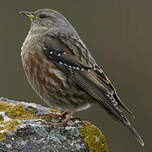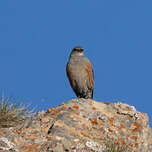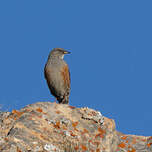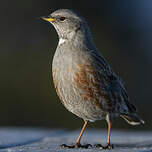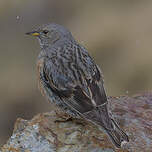Alpine Accentor
Prunella collaris - Accenteur alpin
Identification
The Alpine Accentor is a bulkier bird than its cousin the Meadow Accentor, and also more brightly-coloured. The breeding adult has a grey head marked with a dark red eye and a yellow base to its beak that is clearly visible. The white throat is dotted with black and the grey upperparts are strongly streaked with sooty-black. The white tips of the larger, darker wing-coverts form a clear line in the middle of the wing. The rufous fringes of the secondaries create a clear panel in the wing. The flanks are streaked with broad, russet-to-brown fringes, a colour also found on the scapulars. The long primary projection gives the impression that the dark tail is shorter than it really is.
The juvenile bird has duller plumage than the adult, with reduced russet on the flanks, but the specific characters are already clearly discernable, apart from the throat which is without spots.
There are 9 subspecies, each differing only in slight details of plumage.
Subspecific information 9 subspecies
- Prunella collaris collaris (sw Europe to Slovenia and the Carpathians, nw Africa)
- Prunella collaris subalpina (Croatia to Bulgaria and Greece, Crete and sw Turkey)
- Prunella collaris montana (n and e Turkey to the Caucasus and Iran)
- Prunella collaris rufilata (ne Afghanistan and n Pakistan through the mountains of central Asia to w China)
- Prunella collaris whymperi (w Himalayas)
- Prunella collaris nipalensis (c and e Himalayas to sc China and n Myanmar)
- Prunella collaris tibetana (e Tibet)
- Prunella collaris erythropygia (e Kazakhstan and sc Siberia to ne Siberia, Japan, Korea and ne China)
- Prunella collaris fennelli (Taiwan)
Foreign names
- Accenteur alpin,
- Acentor alpino,
- ferreirinha-serrana,
- Alpenbraunelle,
- havasi szürkebegy,
- Alpenheggenmus,
- Sordone,
- alpjärnsparv,
- Alpejernspurv,
- vrchárka červenkavá,
- pěvuška podhorní,
- Alpe-jernspurv,
- alppirautiainen,
- cercavores alpí,
- Urðartítla,
- płochacz halny,
- Alpu peļkājīte,
- planinska pevka,
- Альпийская завирушка,
- イワヒバリ,
- 领岩鹨,
- alpjärnsparv,
- 岩鷚〔領岩鷚〕,
Voice song and call
Habitat
The Alpine Accentor is typically a bird of high mountains. It nests beyond the upper forest limit, in places where the rocky substratum is exposed, in a context of alpine turf (sloping and rocky outcrops, ravines, scree, .
Behaviour character trait
The Alpine Accentor is a common bird in its alpine habitat. As it is not at all shy, it can be easily approached within a few steps.
This trait is generally seen among birds living in remote areas where people are not present.It can be found in places with a mix of grass and rocks. It feeds on the ground by stepping slowly or making small jumps while scanning the surface. The nest is well hidden in a rock crevice. Very territorial during the breeding season, it forms small groups at the bad season that roam in search of food.
Flight
Dietfeeding habits
The Accenteur alpin's diet is mixed, largely insectivorous in the spring. It is especially tender insects, such as flies, that feed the young. In addition to insects, all sorts of invertebrates, earthworms, spiders, small molluscs, etc., are added. It becomes granivorous towards the end of summer when animal prey become scarce. In winter, it knows how to take advantage of human resources around chalets and in mountain resorts.
Reproduction nesting
The Alpine Accentor species practices polygyny, which means that males seek to fertilize the maximum amount of females and females seek to attract the maximum amount of males.
So, it is mainly the female that takes on the tasks of building the nest and then incubating it. Nesting takes place from May to July. The nest is always perfectly hidden in a rock crevice, or less often under a block of stone or bush in the alpine meadows, and requires a lot of vigilance to find. Sometimes it is even found in the stone walls of mountain chalets. It is very rudimentary and often falls apart when taken out of its context. The outside is made of dry grass stems with the midse composed of moss and the lining of the cup that consists of fine dry herbs, roots and fur. The clutch is 3-4 eggs which are incubated for 11 to 15 days. They are rarely fed by the female alone, more often by the female assisted by one or more males. The chicks leave the nest at 14 to 16 days old.Geographic range
The Alpine Accentor has a Palearctic distribution. It inhabits all high-mountain ranges from the Atlantic to the Pacific at middle latitudes (Pyrenees, Alps, Balkans, Taurus, Himalayas, etc.) with 9 geographically differentiated subspecies. In France, it breeds marginally on the Puys of the Massif Central, and occasionally in the Jura and Vosges. However, the current tendency towards higher temperatures threaten its sustainability in those lower altitude mountains.
The species is mainly sedentary, but in the bad season there is an exodus towards lower altitudes of the occupied mountain ranges, towards adjacent lower altitude mountains and even towards the underlying plains. This is the case in France, where regular winter observations around the Mediterranean coast are noted, thanks to rocky environements, coast cliffs, rocky openings of scrubland and maquis, or quarries. Exceptionally, Alpine Accentors have even been found as far as the centre western part of the country or in the Paris Basin. Pyrenean birds descend towards the Spanish plateaus and plains.
Threats - protection
Sources of information
- IOC World Bird List (v14.2), Gill, F and D Donsker (Eds). 2024-04-18.
- Atlas des oiseaux de France métropolitaine. Nidification et présence hivernale. , Issa Nidal et Muller Y
- Les passereaux d'Europe, tome 2, P. Géroudet, M. Cuisin
- HBW Alive,
- Avibase, Lepage Denis
- xeno-canto, Sharing bird sounds from around the world,
Other sources of interest
 Specification sheet created on
27/07/2023 by Jean François
Specification sheet created on
27/07/2023 by Jean FrançoisTranslation by AI Oiseaux.net
© 1996-2025 Oiseaux.net
- Accipitriformes
- Aegotheliformes
- Anseriformes
- Apodiformes
- Apterygiformes
- Bucerotiformes
- Caprimulgiformes
- Cariamiformes
- Casuariiformes
- Charadriiformes
- Ciconiiformes
- Coliiformes
- Columbiformes
- Coraciiformes
- Cuculiformes
- Eurypygiformes
- Falconiformes
- Galliformes
- Gaviiformes
- Gruiformes
- Leptosomiformes
- Mesitornithiformes
- Musophagiformes
- Nyctibiiformes
- Opisthocomiformes
- Otidiformes
- Passeriformes
- Pelecaniformes
- Phaethontiformes
- Phoenicopteriformes
- Piciformes
- Podargiformes
- Podicipediformes
- Procellariiformes
- Psittaciformes
- Pterocliformes
- Rheiformes
- Sphenisciformes
- Steatornithiformes
- Strigiformes
- Struthioniformes
- Suliformes
- Tinamiformes
- Trogoniformes




















